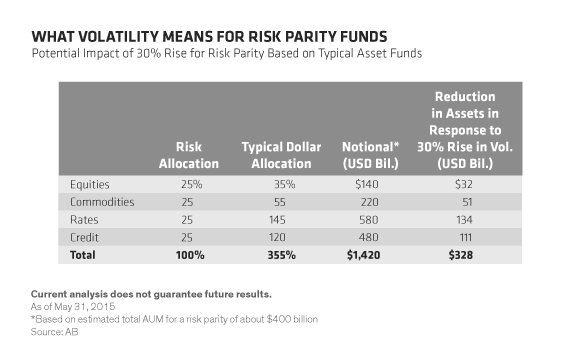Few things make investors queasier than volatility. But usually, the best way to settle the stomach is to breathe deeply and ride out the storm. Regrettably, fewer big investors are doing so nowadays—and that worries us.
Here’s why: bond market liquidity has been drying up, and a growing tendency among large investors to shorten their investment horizons and react to short-term volatility spikes could make the situation worse.
This is because many large investors—pension funds, insurance companies and even high-net-worth individuals—have embraced “risk-aware” strategies. These use volatility-managed or value-at-risk (VaR) techniques to measure their level of portfolio risk. If the risk level falls, managers generally buy more assets. If it rises above a certain level, they generally sell assets to bring it back into line. This behavior can be dangerous, especially when it is driven by a static rules-based investment process.
Focusing on Risk Management
These strategies became popular after the global financial crisis—and it’s easy to see why. Investors who had suffered catastrophic losses in 2008 were determined to avoid a repeat performance.
But here’s the thing about VaR strategies: they work best when the supply and demand of liquidity within the marketplace are matched. This is because managers must be able to rebalance their portfolios when risk measures change. When the demand for liquidity overwhelms the supply of it, the execution price suffers.
A Crowded Trade
With so many investors using these strategies, it’s possible that the selling itself could cause a spike in volatility. That could lead to additional volatility-based selling and worsen already strained liquidity conditions. In other words, investors’ attempts to control risk could, perversely, create a new risk in the market.
We estimate there’s about $300 billion invested in risk-aware insurance products. Risk parity funds, which target a specific level of risk and spread it equally among risky assets (such as stocks and credit) and safer ones (such as government bonds), may have up to $500 billion under management. But when we factor in the leverage that many risk parity funds use, that number swells to almost $2 trillion.
That’s a lot of money—and a pretty crowded trade. It’s always useful to keep an eye on volatility when managing risk. But investors need to be aware that others are doing the same thing. When liquidity is low, this herd mentality can lead to larger-than-expected market fluctuations.
Forced selling—much of it attributed to risk parity and other VaR-related strategies—played a significant role in the 2013 “taper tantrum” and may have contributed to the stock market sell-off last month (Display).

It may help to think about it this way: in today’s markets, VaR-based strategies may be to illiquidity what gasoline is to a fire.
Buying High, Selling Low
We don’t think volatility is going to disappear any time soon—not with emerging-market growth slowing and the timing of the Federal Reserve’s first interest-rate hike in nearly a decade still unclear.
This means that making asset allocation decisions based on short-term fluctuations in volatility can deliver disappointing results. Remember, buying assets when volatility falls and selling them when it rises usually means buying dear and selling cheap—hardly a recipe for high returns.
The Perils of Shortening Your Investment Horizon
We think it’s an especially questionable strategy for large institutional investors. These investors are ideally suited to take the long view and ride out short-term volatility because they boast the twin luxuries of large balance sheets and long investment horizons.
VaR-based strategies erase the time advantage by forcing investors who should be managing their portfolios according to a 10- or 20-year horizon to focus on the next three to six months instead.
The worst of these strategies are those that require the mechanical buying or selling of assets based on moves in short-term volatility. If volatility suddenly spikes, managers who use this strategy usually end up selling assets that have already declined in price.
Ditch the Automated Approach and Go Active
So what’s the alternative? We think it’s a more hands-on, active approach. Skilled active managers can design strategies that allow them to buy assets when they cheapen and sell them when they get expensive. These are likely to lead to better investment returns.
Active managers can also buy “call” or “put” options—the right to buy or sell an asset in the future at a predetermined price—to help protect against big liquidity-induced market moves.
In our view, it’s time for big investors to get back to basics and start making decisions on measures of long-term value rather than short-term turbulence. Those who take this step—and a few others —may be able to turn today’s less liquid conditions to their advantage.
The views expressed herein do not constitute research, investment advice or trade recommendations and do not necessarily represent the views of all AB portfolio-management teams.